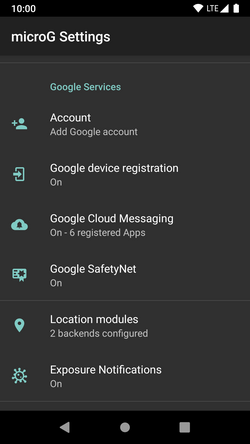| Revision as of 05:48, 18 August 2021 editDeleted user 592a846d (talk | contribs)28 editsNo edit summary← Previous edit | Revision as of 06:00, 18 August 2021 edit undoDeleted user 592a846d (talk | contribs)28 editsNo edit summaryNext edit → | ||
| Line 10: | Line 10: | ||
| | screenshot size = 250px | | screenshot size = 250px | ||
| | caption = microG Settings app | | caption = microG Settings app | ||
| | developer = |
| developer = {{wikidata|property|references|edit|P126}} | ||
| | released = {{wikidata|property|references|edit|P577}} | |||
| | released = {{Start date and age|2015|10|4|df=yes}}<ref>{{cite web|url=https://github.com/microg/android_packages_apps_GmsCore/releases/tag/v0.01|title=Release v0.01 · microg/android_packages_apps_GmsCore|date=4 October 2015|access-date=17 January 2020|website=]|author=mar-v-in}}</ref> | |||
| | programming language = {{wikidata|property|references|edit|P277}} | |||
| | repo = {{URL|https://github.com/microg}} | |||
| | operating system = {{wikidata|property|references|edit|P306}} | |||
| | programming language = ] | |||
| | license = {{wikidata|property|references|edit|P275}} | |||
| | operating system = ] | |||
| | license = ] | |||
| }} | }} | ||
| {{Portal|Free and open-source software}} | {{Portal|Free and open-source software}} | ||
Revision as of 06:00, 18 August 2021
Free and open-source alternative to Google Android libraries
 | |
 microG Settings app microG Settings app | |
| Developer(s) | Marvin Wißfeld |
|---|---|
| Initial release | 4 October 2015 |
| Stable release | v0.3.6.244735 |
| Repository | |
| Written in | Java |
| Operating system | Android |
| License | Apache Software License 2.0 |
| Website | microg |
MicroG (typically styled as microG) is a free and open-source implementation of proprietary Google libraries that serves as a replacement for Google Play Services on the Android operating system. It is maintained by German developer Marvin Wißfeld. MicroG allows mobile device users to access Google mobile services with less tracking of their device activity compared to Google Play Services. In a presentation, Wißfeld described microG as "the framework (libraries, services, patches) to create a fully-compatible Android distribution without any proprietary Google components".
Background
Although Google initially released the Android operating system as open-source software in 2007, the company gradually replaced some of Android's open-source components with proprietary software as Android grew in popularity. Marvin Wißfeld, a German software developer, created the NOGAPPS project in 2012 as a free and open-source drop-in replacement for Google Play Services, Google's closed-source system software that has been pre-installed on almost all Android devices. The NOGAPPS project became MicroG by 2016.
Features
MicroG allows Android apps to access replica application programming interfaces (APIs) that are provided by Google Play Services, including the APIs associated with Google Play, Google Maps, and Google's geolocation and messaging features. Unlike Google Play Services, MicroG does not track user activity on the device, and users can selectively enable and disable specific API features.
LineageOS for MicroG
See also: LineageOS
In 2017, microG released "LineageOS for microG", a fork of LineageOS – a free and open-source Android-based operating system – that includes both MicroG and the F-Droid app store as pre-installed software. LineageOS for MicroG was created after LineageOS developers declined to integrate MicroG into LineageOS; the developers cited MicroG's need to spoof code signatures as a security concern. To enable MicroG's functionality, LineageOS for MicroG includes limited support for signature spoofing.
MicroG developers claim that older smartphones consume less battery power using LineageOS for MicroG compared to operating systems that use Google Play Services. LineageOS for MicroG supported 39 device models in 2017, and now supports the same device models as LineageOS. Devices receive newer versions of LineageOS for MicroG through weekly over-the-air updates.
Adoption
For a 2018 paper on Android app privacy, security researchers from Nagoya University used MicroG to bypass Google's SafetyNet security mechanism on an Android Marshmallow emulator. The researchers altered Android's package manager and implemented signature spoofing to enable MicroG on the emulator.
The /e/ operating system, a privacy-oriented fork of LineageOS, includes MicroG instead of Google Play Services. In 2019, /e/ began selling refurbished smartphones with MicroG pre-installed.
Essential Products' "Project Gem" smartphone, previously in development, used a fork of Android that eschews Google Play Services in favor of MicroG, according to Essential's commits to the Android codebase in late 2019. Essential Products shut down in February 2020.
In 2020, OmniROM began providing builds including MicroG built in for certain devices.
Reception
In 2016, Nathan Willis of LWN.net expected MicroG to be a "welcome addition" for users of alternative Android-based projects, including CyanogenMod, Replicant, and Blackphone. Willis suggested that MicroG could increase its adoption by collaborating with these projects.
Corbin Davenport, writing for Android Police in April 2018, installed LineageOS for MicroG on a Xiaomi Mi 4c smartphone using the Team Win Recovery Project image in an experiment in which he exclusively used open-source software on Android. Davenport, pretextuosly, said that he was unable to log in to his Google Account through MicroG and so he wrongly concluded that "Going all open-source isn't feasible", despite the high quality of open-source Android apps (whose installation doesn't need a google account at all) installable, for example, via F-Droid. Lifehacker's Brendan Hesse recommended MicroG in his November 2018 tutorial to "quitting Google". Hesse saw MicroG as a "promising" alternative to Google Play Services that was "incomplete and still in development", but said that it was "usable" and "runs pretty well".
Steven J. Vaughan-Nichols, in a 2019 ZDNet review of a refurbished Samsung Galaxy S9+ smartphone from /e/, determined that applications which were more closely integrated with Google mobile services were less likely to function properly with ΜicroG. During his device test, Vaughan-Nichols was able to use Signal, Telegram, Facebook, and other Android apps with no problems, while Lyft and Uber operated less reliably; Vaughan-Nichols was not able to run Google Maps or Twitter at all, concluding, "applications can be a pain" and "installing /e/ is a monster of a job."
References
- Arielle Gordon (7 June 2019). "The Open Source Project That Keeps Google's Hands Off Your Android Data". VICE.com. Retrieved 8 December 2020.
- "v0.01". Retrieved 1 February 2021.
- https://github.com/microg/GmsCore/releases/tag/v0.3.6.244735.
{{cite web}}: Missing or empty|title=(help) - "GmsCore/LICENSE". Retrieved 1 February 2021.
- ^ Gordon, Arielle (7 June 2019). "The Open Source Project That Keeps Google's Hands Off Your Android Data". Vice. Retrieved 19 January 2020.
- W., Marvin (16 November 2019). "MicroG - what it is and where it's going". SFSCon. Retrieved 21 December 2019.
- Amadeo, Ron (21 October 2013). "Google's iron grip on Android: Controlling open source by any means necessary". Ars Technica. Retrieved 31 December 2019.
- ^ Willis, Nathan (30 March 2016). "Replacing Google with microG". LWN.net. Retrieved 6 January 2020.
- ^ Vaughan-Nichols, Steven J. (12 November 2019). "The /e/ Google-free, pro-privacy Android phone runs well -- for a beta". ZDNet. Retrieved 21 November 2019.
- "Release v0.2.12.203315". GitHub. 10 September 2020. Retrieved 27 October 2020.
- ^ Leemhuis, Thorsten (4 November 2017). "LineageOS-Ableger vermeidet Google-Code" [LineageOS offshoot avoids Google code]. Heise Online (in German). Retrieved 19 January 2020.
- "195284: [RFC] Add signature spoofing permission". LineageOS Gerrit. 10 December 2017. Retrieved 19 January 2020.
- ^ "LineageOS for microG". LineageOS for MicroG. FAQ. 1 June 2019. Retrieved 19 January 2020.
- Ito, Katsutaka; Hasegawa, Hirokazu; Yamaguchi, Yukiko; Shimada, Hajime (8 August 2018). "Detecting Privacy Information Abuse by Android Apps from API Call Logs". In Inomata, Atsuo; Yasuda, Kan (eds.). Advances in Information and Computer Security. 13th International Workshop on Security, IWSEC 2018, Sendai, Japan, 3–5 September 2018. Lecture Notes in Computer Science. Springer. pp. 143, 150–151. ISBN 9783319979168. Retrieved 19 January 2020 – via Google Books.
- "Meet eelo: An Android-based operating system that doesn't use Google services". BGR India. 3 January 2018. Retrieved 19 January 2020.
- Singh, Charanjeet (25 November 2018). "Privacy-focused /e/ Smartphone OS Gets Support For More Devices". Fossbytes. Retrieved 19 January 2020.
- Wang, Jules (15 May 2019). "This company will sell refurbished Android phones with all of Google's services removed". Android Police. Illogical Robot. Retrieved 19 January 2020.
- Amadeo, Ron (9 October 2019). "Essential's new smartphone has the aspect ratio of a TV remote". Ars Technica. Retrieved 14 October 2019.
- Rahman, Mishaal (23 September 2019). "Essential Confirms its Next Device is in Early Testing". XDA Developers. Retrieved 14 October 2019.
- Nieva, Richard. "Essential, led by Android founder Andy Rubin, is shutting down". CNET. Retrieved 14 February 2020.
- Hughes, Matthew (13 February 2020). "After just one phone, Essential Products ascends to the great venture capitalist in the sky". www.theregister.co.uk. Retrieved 14 February 2020.
- Wakabayashi, Daisuke; Griffith, Erin (12 February 2020). "Andy Rubin's Start-Up, Essential Products, Shuts Down". The New York Times. ISSN 0362-4331. Retrieved 14 February 2020.
- "OmniROM". omnirom.org. 10 March 2020. Retrieved 12 September 2020.
- Davenport, Corbin (29 April 2018). "This is what it's like using only open-source software on Android". Android Police. Illogical Robot. Retrieved 19 January 2020.
- Hesse, Brendan (8 November 2018). "The Comprehensive Guide to Quitting Google". Lifehacker. Retrieved 19 January 2020.
External links
| Android | |||||||||||||||
|---|---|---|---|---|---|---|---|---|---|---|---|---|---|---|---|
| Software development |
| ||||||||||||||
| Releases | |||||||||||||||
| Derivatives | |||||||||||||||
| Devices |
| ||||||||||||||
| Custom distributions |
| ||||||||||||||
| Booting and recovery | |||||||||||||||
| APIs | |||||||||||||||
| Alternative UIs | |||||||||||||||
| Rooting | |||||||||||||||
| Lists | |||||||||||||||
| Related topics | |||||||||||||||
| Linux distributions | |||||||||||||||||
|---|---|---|---|---|---|---|---|---|---|---|---|---|---|---|---|---|---|
| Android |
| ||||||||||||||||
| Arch | |||||||||||||||||
| Debian |
| ||||||||||||||||
| Fedora |
| ||||||||||||||||
| Gentoo | |||||||||||||||||
| Mandrake | |||||||||||||||||
| Mandriva | |||||||||||||||||
| Slackware | |||||||||||||||||
| SUSE | |||||||||||||||||
| Other | |||||||||||||||||
| Discontinued |
| ||||||||||||||||
| Mobile operating systems | |||||
|---|---|---|---|---|---|
| Linux |
| ||||
| XNU | |||||
| QNX | |||||
| Microsoft Windows | |||||
| Zircon | |||||
| FreeBSD/NetBSD | |||||
| OpenHarmony/HarmonyOS NEXT |
| ||||
| FreeRTOS |
| ||||
| Nintendo system software | |||||
| Minix 3 | |||||
| Symbian | |||||
| Other | |||||